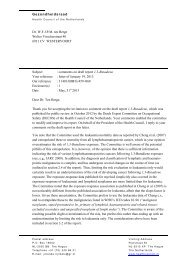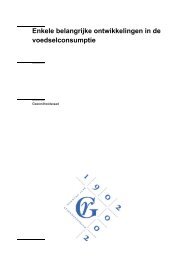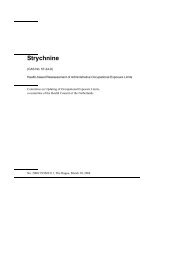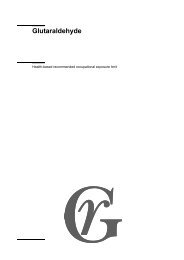Liquefied petroleum gas (LPG) - Gezondheidsraad
Liquefied petroleum gas (LPG) - Gezondheidsraad
Liquefied petroleum gas (LPG) - Gezondheidsraad
You also want an ePaper? Increase the reach of your titles
YUMPU automatically turns print PDFs into web optimized ePapers that Google loves.
amount of oxygen in contact with the food in the packaging (see Code of Federal<br />
Regulations: 21CFR184.1165; revised as of April 1, 2003).<br />
5 Biotransformation and kinetics<br />
<strong>LPG</strong><br />
In male ICR mice exposed to an unknown concentration of <strong>LPG</strong> (composition:<br />
97.4% propane, 0.3% butane, 1.2% ethane, and 1.1% 2-methylpropane) for 2<br />
hours, propane, butane, and 2-methylpropane and the metabolites 2-propanol,<br />
acetone, 2-butanol, and 2-butanone were identified in blood, brain, liver, and<br />
kidneys (Tsu85a).<br />
Propane<br />
One hour after inhalation of an unknown concentration of propane, unchanged<br />
compound was detected in blood, brain, liver, and kidneys of male ICR mice. 2-<br />
Propanol and acetone, metabolites of propane, were also identified. Following<br />
incubation of a saturated aqueous solution of propane (ca. 2.9 mM) with a mouse<br />
liver microsomal suspension in the presence of a NADPH-generating system,<br />
Tsukamoto et al. only found 2-propanol, while no ketone was detected. From<br />
these data, the authors presumed that propane was first metabolised into a<br />
secondary alcohol, 2-propanol, by the microsomal enzyme system and then into<br />
the corresponding ketone, acetone, by alcohol dehydrogenase (Tsu85a, Tsu85b).<br />
Propane has been detected in blood, brain, kidney, liver, and lungs of man<br />
following fatal propane exposure (Ber95a, Gra99).<br />
Butane<br />
In humans, absorption of butane was reported to be 30-45% of the dose inhaled<br />
(Fla90). Although the committee did not find data on absorption through the<br />
skin, dermal penetration of butane is expected to be low since skin contact is<br />
transient due to the volatility of the compound (Low87b).<br />
In a fatal case of butane abuse, levels of butane in liver, brain, blood, and<br />
kidneys amounted to 310, 282, 129, and 84 mg/kg or mg/L, respectively (Gra99).<br />
In rats exposed to a butane concentration of 100 ppm (240 mg/m 3 ) for 80<br />
minutes, the uptake was estimated to be 1.5-1.8 nmol/kg/min/ppm (0.09-0.1<br />
µg/kg/min/ppm) (Dah88). From this, a retention of ca. 10% can be calculated<br />
(assuming a rat body weight of 300 g and a minute volume of 125 mL/min).<br />
134-6 Health-based Reassessment of Administrative Occupational Exposure Limits
















